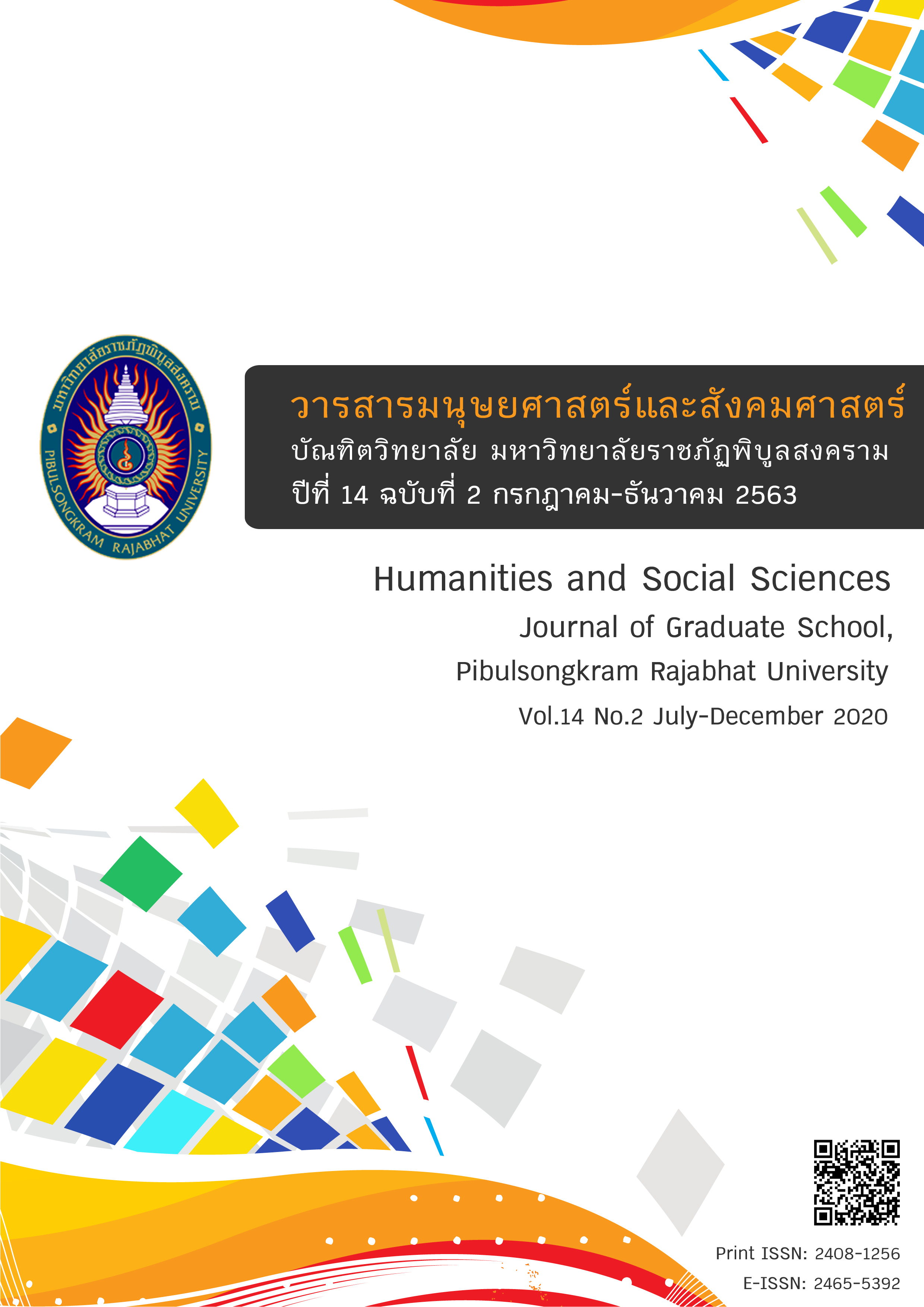การศึกษาคำปรากฏร่วมในงานเขียนภาษาอังกฤษของผู้เรียนชาวไทย: กรณีศึกษามหาวิทยาลัยในภาคเหนือ 3 แห่ง
คำสำคัญ:
คำปรากฏร่วม, งานเขียนของผู้เรียน, มหาวิทยาลัยในภาคเหนือบทคัดย่อ
งานวิจัยนี้มีจุดมุ่งหมายเพื่อศึกษารูปแบบการใช้คำปรากฏร่วมในงานเขียนของผู้เรียนภาษาอังกฤษชาวไทยในมหาวิทยาลัยภาคเหนือ 3 แห่ง และเพื่อศึกษาประเภทรูปแบบคำปรากฏร่วมที่ผู้เรียนสามารถใช้ได้เทียบเคียงใกล้เคียงเจ้าของภาษาโดยใช้เกณฑ์การปรากฏในคลังข้อมูลภาษาของเจ้าของภาษา 2 แหล่ง งานเขียนที่ใช้ในการวิเคราะห์คืองานเขียนภาษาอังกฤษของผู้เรียนภาษาอังกฤษชาวไทยในมหาวิทยาลัยภาคเหนือ 3 แห่ง จำนวน 213 ชิ้นงาน คลังข้อมูลภาษาได้แก่ Oxford Collocation Dictionary for Students of English และคลังข้อมูลภาษา COCA Corpus วิเคราะห์ข้อมูลโดยใช้สถิติพรรณนาร้อยละ ผลการวิจัยพบว่า มีการใช้คำปรากฏร่วมรวมทั้งสิ้น 1,858 คำ ผู้เรียนใช้คำปรากฏร่วมประเภท Adjective + Noun มากที่สุด จำนวน 1,085 คำ คิดเป็นร้อยละ 58.40 คำปรากฏร่วมลำดับรองลงมา ได้แก่ ประเภท Verb + Preposition จำนวน 432 คำ คิดเป็นร้อยละ 23.25 คำปรากฏร่วม ประเภท Verb + Noun จำนวน 201 คำ คิดเป็นร้อยละ 10.82 และคำปรากฏร่วมประเภท Noun + Noun จำนวน 140 คำ คิดเป็นร้อยละ 7.53 ตามลำดับ ส่วนความสามารถในการใช้เมื่อเทียบกับการพบในแหล่งคลังข้อมูลภาษา 2 แหล่ง คือ Oxford Collocation Dictionary และ COCA corpus ผู้เรียนสามารถใช้ประเภทคำปรากฏร่วม Verb + Preposition ได้มากที่สุด รองลงมาได้แก่คำปรากฏร่วมประเภท Adjective + Noun, Verb + Noun และ Noun + Noun ตามลำดับ
เอกสารอ้างอิง
กะรัตเพชร คงรอด. (2560). การวิเคราะห์ข้อผิดพลาดด้านการใช้คำในการเขียนภาษาอังกฤษเชิงวิชาการของนักศึกษาไทยระดับปริญญาตรี (วิทยานิพนธ์ศึกษาศาสตรมหาบัณฑิต). มหาวิทยาลัยศิลปากร, กรุงเทพฯ.
ดวงกมล ฐิติเวส. (2554). ผลการใช้กิจกรรมการเรียนรู้แบบร่วมมือตามแนวการสอนภาษาเพื่อการสื่อสารในการสอนกฎไวยากรณ์ ภาษาอังกฤษ ของผู้เรียนครูในมหาวิทยาลัยราชภัฏสวนสุนันทา (วิทยานิพนธ์ครุศาสตรบัณฑิต). มหาวิทยาลัยราชภัฏสวนสุนันทา, กรุงเทพฯ.
ธารทอง แจ่มไพบูรย์. (2559). พัฒนาการของคำศัพท์ที่มีความถี่ในการปรากฏสูงในหนังสือเรียนวิชาภาษาไทย: การศึกษาตามแนวทางภาษาศาสตร์ คลังข้อมูล (วิทยานิพนธ์อักษรศาสตรดุษฎีบัณฑิต). จุฬาลงกรณ์มหาวิทยาลัย, กรุงเทพฯ.
เนาวรัตน์ อินทรประสิทธิ์. (2556). การศึกษาการปรากฏของคำปรากฏร่วมในหนังสือนวนิยายภาษาอังกฤษ. พระนครศรีอยุธยา: คณะศิลปศาสตร์ มหาวิทยาลัยเทคโนโลยีราชมงคลสุวรรณภูมิ.
รัชดาวัลย์ ศรีวรกุล. (2558). การสร้างแบบฝึกเสริมทักษะการใช้ ภาษาอังกฤษสำหรับนักเรียนที่มีผลสัมฤทธิ์ทางการเรียนต่ำของนักเรียนระดับชั้น ป.1/5 โรงเรียนอัสสัมชัญแผนกประถม. กรุงเทพฯ: โรงเรียนอัสสัมชัญแผนกประถมกรุงเทพฯ.
วงศ์ วรรธนพิเชษฐ. (2556). Collocation: ต้นเหตุสําคัญที่ทําให้คนไทยเขียนและพูดภาษาอังกฤษไม่ได้มาตรฐาน. สืบค้น 19 ธันวาคม 2562, จาก www.dicthai.com
สุปรานี พุ้ยมอม, เจนจิรา เกิดทอง และชนิศา นิ่มสะอาด. (2555). การสำรวจการใช้คำปรากฏร่วม (Collocation) ในงานเขียนของผู้เรียนไทยระดับปริญญาตรี. สืบค้น 11 พฤศจิกายน 2562, จาก http://research.rmutsb.ac.th.
สุวนันทน์ อินมณี และพยุง ซีดาร์. (2559). การศึกษาการใช้คำพหุกริยาภาษาอังกฤษในกลุ่มคำศัพท์ทางวิชาการโดยใช้คลังข้อมูลภาษา. สักทอง: วารสารมนุษยศาสตร์และสังคมศาสตร์, 22(1), 57-69.
อังคนา มงคลชัย. (2551). การศึกษาความสามารถของผู้เรียนระดับมหาวิทยาลัยในการใช้คำปรากฏร่วม (วิทยานิพนธ์ศิลปศาสตรมหาบัณฑิต). มหาวิทยาลัยศรีนครินทรวิโรฒ, กรุงเทพฯ.
Benson, M. (1985). Collocations and Idioms. In Ilson, R. (Ed.). Dictionaries, Lexicography and Language Learning. Oxford: British Council: Pergamon Press.
Bueraheng, N. (2014). Receptive and productive knowledge of Verb + Noun and Adjective + Noun Collocations of International Program and English Major Students of Prince of Songkla University (Thesis of Master of Arts). Prince of Songkla University.
Chuenchaichon, Y. (2014). A review of EFL writing research studies in Thailand in the past 10 years. Journal of Humanities, 11(1), 13-30.
Hashemi, M., Azizinezhad, M., & Dravishi, S. (2012). The Investigation of collocational errors in university students’ writing majoring in English. Procedia-Social and Behavioral Sciences, 31, 555-558.
Lewis, M. (2000). Teaching collocation: Further developments in the Lexical Approach. Hove: Language Teaching.
Lewis, M. (2008). Implementing the lexical approach: putting theory into practice. Hampshire: Heinle Cengage Learning.
Nesselhauf, N. (2003). The use of collocations by advanaced learners of English and Some Implications for teaching. Applied Linguistics, 24(2), 223-242.
Phoocharoensil, S. (2011). Collocational errors in EFL learners' interlanguage. Journal of Education and Practice, 2(3), 103-120.
Shamsudin, S., Sadoughvanini, S., & Zaid, Y. H. (2013). Iranian EFL learners’ collocational errors in speaking skill. Social and Behavioral Sciences, 70, 1295-1302.
Shitu, F. M. (2015). Collocation errors in English as second language (ESL) essay writing. World Academic of Science, Engineering and Technology International Journal of Cognitive and Language Sciences, 9(9), 3270-3277.
Sinclair, J. (1999). Corpus, concordance, collocation. Oxford: Oxford University Press.
Suwitchanphan, P., & Phoocharoensil, S. (2014). Adjective + noun collocation competence of L1 Thai Learners: A comparative study of a regular Program and an English program. Asian Social Science, 10(17), 210-221.
Yumanee, C., & Phoocharoensil, S. (2013). Analysis of collocational errors of Thai EFL students. LEARN Journal, 6(1), 88-98.
ดาวน์โหลด
เผยแพร่แล้ว
รูปแบบการอ้างอิง
ฉบับ
ประเภทบทความ
สัญญาอนุญาต
บทความหรือข้อคิดเห็นใดใดที่ปรากฏในวารสารมนุษยศาสตร์และสังคมศาสตร์ มหาวิทยาลัยราชภัฏพิบูลสงครามเป็นวรรณกรรมของผู้เขียน ซึ่งบรรณาธิการไม่จำเป็นต้องเห็นด้วย บทความที่ได้รับการตีพิมพ์เป็นลิขสิทธิ์ของวารสารมนุษยศาสตร์และสังคมศาสตร์ มหาวิทยาลัยราชภัฏพิบูลสงคราม









